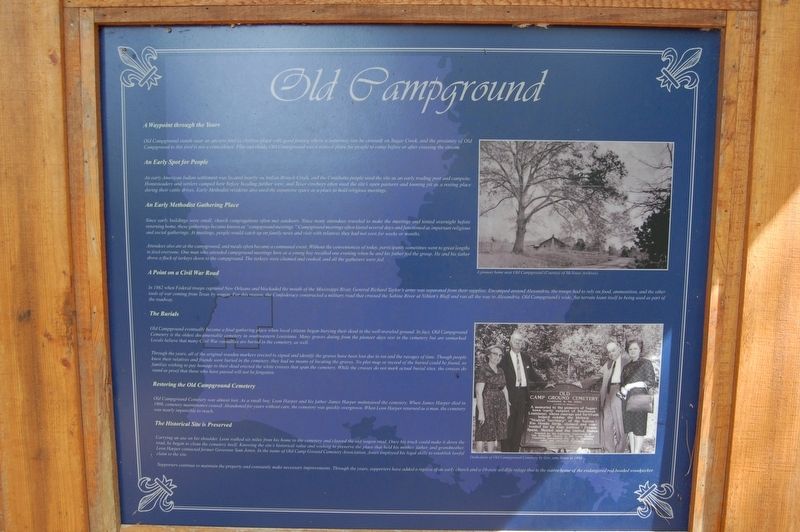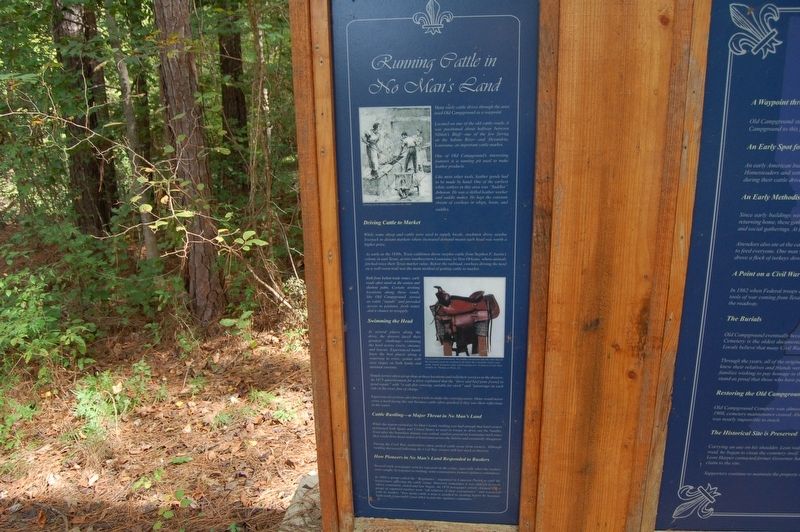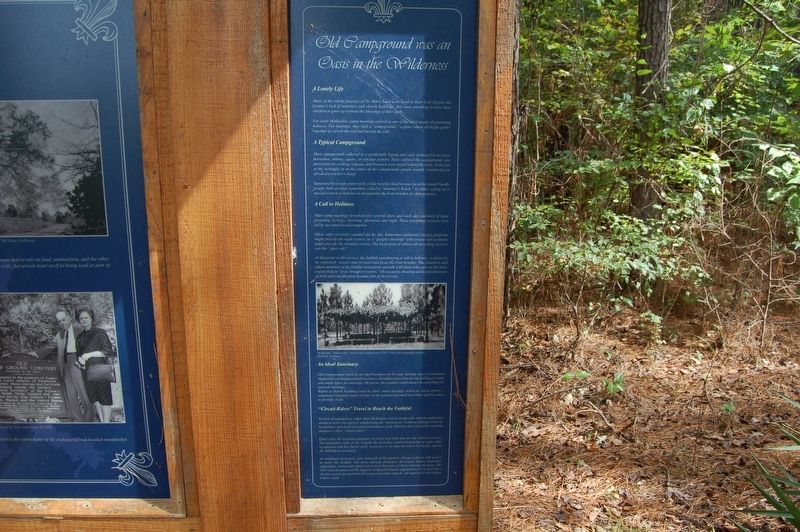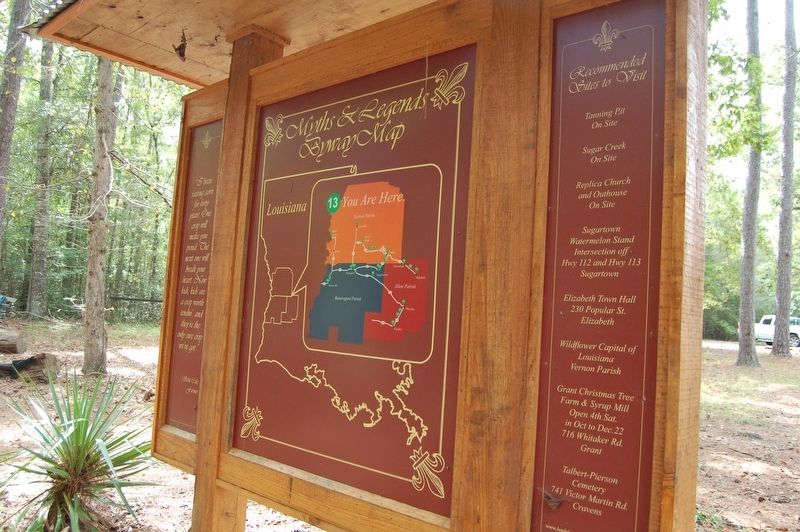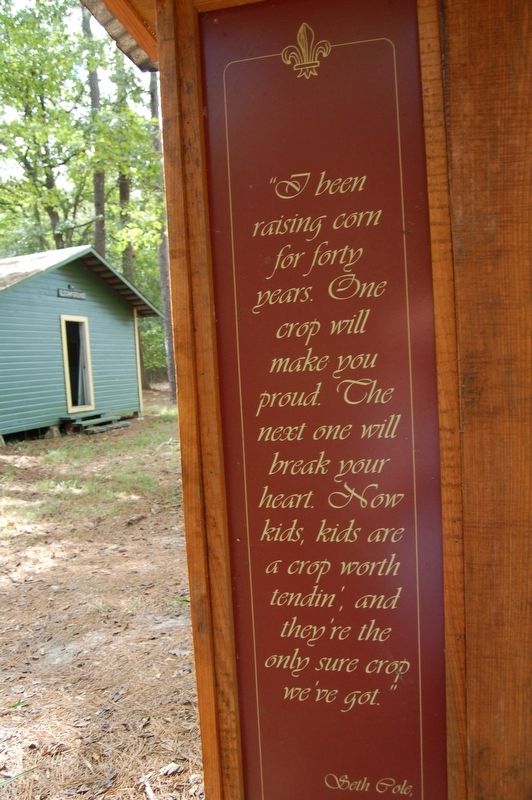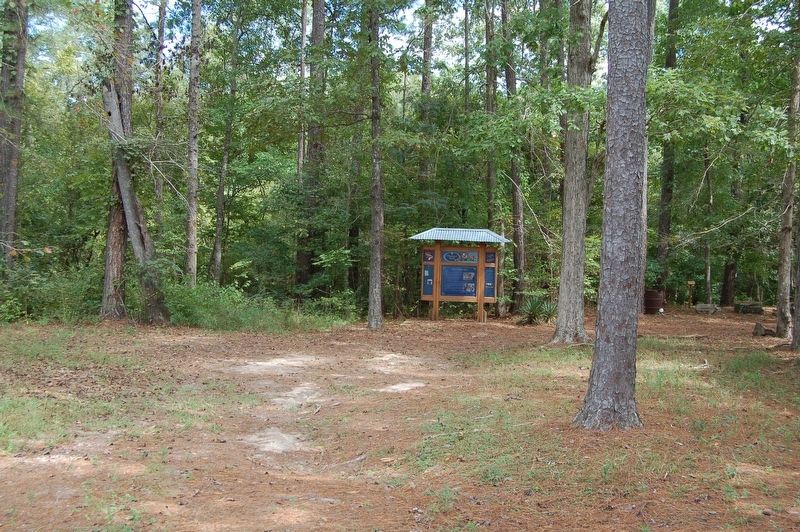Dry Creek in Beauregard Parish, Louisiana — The American South (West South Central)
Old Campground
Myths & Legends - Beauregard Parish
Main Panel
A Waypoint through the Years
Old Campground stands near an ancient ford (a shallow place with good footing where a waterway can be crossed) on Sugar Creek, and the proximity of Old Campground to this ford is not a coincidence, Flat and shady, Old Campground was a natural place for people to camp before or after crossing the stream.
An Early Spot for People
An early American Indian settlement was located nearby on Indian Branch Creek, and the Coushatta people used the site as an early trading post and campsite. Homesteaders and settlers camped here before heading further west, and Texas cowboys often used the sites open pastures and tanning pit as a resting place during their cattle drives. Early Methodist residents also used the expansive space as a place to hold religious meetings.
An Early Methodist Gathering Place
Since early buildings were small, church congregations ofien met outdoors. Since many attendees traveled to make the meetings and tented overnight before returning home, these gatherings became known as "campground meetings, "Campground meetings often lasted several days and functioned as important religious and social gatherings. At meetings, people would catch up on family news and visit with relatives they had not seen for weeks or months.
Attendees also ate at the campground, and meals often became a communal event. Without the conveniences of today, participants sometimes went to great lengths to feed everyone. One man who attended campground meetings here as a young boy recalled one evening when he and his father fed the group. He and his father drove a flock of turkeys down to the campground. The turkeys were cleaned and cooked, and all the gatherers were fed.
A Point on a Civil War Road
In 1862 when Federal troops captured New Orleans and blockaded the mouth of the Mississippi River, General Richard Taylor's army was separated from their supplies. Encamped around Alexandria, the troops had to rely on food, ammunition, and the other tools of war coming from Texas by wagon. For this reason, the Confederacy constructed a military road that crossed the Sabine River at Niblets Bluff and ran all the way to Alexandria. Old Campground's wide, flat terrain leant itself to being used as part of the roadway.
The Burials
Old Campground eventually became a final gathering place when local citizens began burying their dead in the well-traveled ground. In fact, Old Campground Cemetery is the oldest documentable cemetery in southwestern Louisiana. Many graves dating from the pioneer days rest in the cemetery but are unmarked. Locals believe that many Civil War casualties are buried in the cemetery, as well. Through the years, all of the original wooden markers erected to signal and identify the graves have been lost due to rot and the ravages of time. Though people knew their relatives and friends were buried in the cemetery, they had no means of locating the graves. No plot map or record of the buried could be found, so families wishing to pay homage to their dead erected the white crosses that span the cemetery. While the crosses do not mark actual burial sites, the crosses do stand as proof that those who have passed will not be forgotten.
Restoring the Old Campground Cemetery
Old Campground Cemetery was almost lost. As a small boy, Leon Harper and his father James Harper maintained the cemetery: When James Harper died in 1908, cemetery maintenance ceased. Abandoned for years without care, the cemetery was quickly overgrown. When Leon Harper returned as a man, the cemetery was nearly impossible to reach.
The Historical Site is Preserved
Carrying an axe on his shoulder, Leon walked six miles from his home to the cemetery and cleared the old wagon road, Once his truck could make it down the road, he began to clean the cemetery itself. Knowing the site's historical value and wishing to preserve the place that held his mother, father, and grandmother Leon Harper contacted former Governor Sam Jones, In the name of Old Camp Ground Cemetery Association, Jones employed his legal skills to establish lawful claim to the site.
Supporters continue to maintain the property and constantly make necessary improvements. Through the years, supporters have added a replica of an early church and a 10-acre wildlife refuge that is native home of the endangered red-headed woodpecker.
Left Panel
Running Cattle in No Man's Land
Man early cattle drives through the area used Old Campground as a waypoint. Located on one of the old cattle roads, it was positioned about halfway between Nibletts Bluff-one of the few ferries on the Sabine River and Alexandria, Louisiana, an important cattle market.
One of Old Campground's interesting features is a tanning pit used to make leather products.
Like most other tools, leather goods had to be made by hand. One of the earliest white settlers in this area was "Saddler" Johnson. He was a skilled leather worker und saddle maker. He kept the constant stream of cowboys in whips, boots, and saddles.
Driving Cattle to Market
While some sheep and cattle were used to supply locals, stockmen drove surplus livestock to distant markets where increased demand mount each head was worth a higher price.
As early as the 1830s, Texas cattlemen drove surplus cattle from Stephen F Austin's colony in east Texas, across southwestern Louisiana, to New Orleans, where animals fetched twice their Texas market value. Before the railroad, cowboys driving the herd on a well-worn trail was the main method of getting cattle to market.
Built from Indian trade routes, early roads often stood as the easiest and shortest paths. Certain inviting locations along these roads. like Old Campground, served six cattle "stands" and provided access to pastures, fresh water, and a chance to resupply.
Swimming the Head
At several places along the drive the drovers faced their greatest challenge swimming the herd across rets, streams, und bayous. Experienced lands knew the best places along a water to cross-points with easy slopes on both banks and the minimal currents.
Simple ferries often set up shop at these locations and sold their services to the drovers, An 1875 advertisement for a ferry explained that the "ferry and best pens [were] in good repair" with "a safe flat crossing, suitable for stock" and "pasturage on each side of the river, free of charge."
Experienced cowboys also know tricks to make the crossing easier. Many would never cross a herd facing the sun because cattle often spooked if they saw their reflections in the water.
Cattle Rustling-a Major Threat in No Man's Land
While the region existed as No Man's Land, rustling was bad enough that land owners petitioned both Spain and United States to send in troops to drive out the bandits. Even after the boundary dispute was settled, rustlers preyed on Louisiana stock since they could drive head roles in Louisiana cross the Sabine und essentially disappear. During the Civil War, jayhawkers often rustled cattle away from owners. Although rustling decreased following the Civil War owners still lost stock to thievery.
How Pioneers in No Man's Land Responded to Rustlers
Several early newspaper articles reported on the crime, especially when the rustlers were caught in response to rustling, some communities formed vigilance committees.
In 1884 a group called the "Regulators" organized in Cameron Parish to curb the lawlessness afflicting the cattle range. However, sometimes it was difficult to know where criminality ended and law began. An 1870 newspaper article claimed that a group of captured rustlers were "all relatives of their executioners" and wondered with its readers "how many cattle a man is justified in stealing before he becomes sufficiently respectable [and able] to join the vigilance committee."
Right Panel
Old Campground was an Oasis in the Wilderness
A Lonely Life
Many of the sturdy pioneers of No Man's Land were loyal to their God. Despite the frontiers lack of ministers and church buildings, they were unwilling to have their children to grow up without the blessings of their faith.
For early Methodists, camp meetings existed as one of the chief means of promoting holiness. For meetings, they built a "campground," a place where all might gather together to refresh the soul and accept the call.
A Typical Campground Most campgrounds adhered to a predictable layout and were arranged in an open horseshoe, oblong square, or circular pattern. Tents outlined the campground, and provisions for cooking, wagons, and livestock were stored behind the tents. At the end of the rectangle or at the center of the campground, people usually constructed an elevated preacher's stand.
Separated by a wide center aisle, crude benches lined in rows faced the stand. Finally people built an altar, sometimes called a "mourner bench,“ by either setting up a special section of benches or designating the front benches for that purpose.
A Call to Holiness Most camp meetings stretched over several days, and each day consisted of three preaching services - morning, afternoon, and night. These preaching services were led by an experienced evangelist.
Often, other activities rounded out the day. Sometimes additional singing programs might precede the night service, or a "peoples meeting" with prayer and testimony might precede the morning service. The focal point of almost all preaching services was the "altar call."
At that point in the service, the faithful experiencing a call to holiness-a desire to be converted-would come forward and sit on the front benches. The preachers and others members of the faithful would pray and talk with those who came to the altar, urging them to "pray through to victory." On occasion, shouting and loud professions of faith and sanctification became part of the service.
An Ideal Sanctuary
Old Campground stood as an ideal location for a camp meeting since it contained shade from overhanging hardwood trees, abundant water from spring-fed Sugar Creek und ample space for meetings. Of course, the weather could always be a problem for open-air meetings.
Before a church building could be built, many meetings relied on brush arbors temporary structure's made of poles in the ground and small tree limbs and branches to provide shade.
"Circuit Riders" Travel to Reach the Faithful
Several denominations other than Methodists relied on periodic church gatherings meant to revive the spirit or simply bring the "good news" to those wishing to hear it. In addition, nearly all of western Louisiana early churches were served by traveling ministers called "circuit riders."
Quite often the traveling preacher received very little pay for his clerical services, and sometimes none at all. Usually the preacher combined farming or some other occupation with his church work, so for five or six days he toiled on the job, and on the Sabbath he preached.
As settlement increased, some demands of the minister changed but he still needed to move the faithful. The most talented preachers developed almost legendary reputations, and people often look back at the power of these old-time meetings. The 1915 church minutes of the Sugartown Baptist Church, organized in 1878, described 10-day revival during which 65 people joined the church all baptized in the Ouiska Chitto Creek. (Marker Number 13.)
Topics and series. This historical marker is listed in these topic lists: Cemeteries & Burial Sites • Churches & Religion. In addition, it is included in the Louisiana Myths & Legends Byway series list.
Location. 30° 49.451′ N, 92° 59.864′ W. Marker is in Dry Creek, Louisiana, in Beauregard Parish. Marker is on Old Campground Cemetery Road, half a mile east of Pentecostal Church Road (Parish Highway 370). Touch for map. Marker is in this post office area: Dry Creek LA 70637, United States of America. Touch for directions.
Other nearby markers. At least 8 other markers are within 11 miles of this marker, measured as the crow flies. Old Camp Ground Cemetery (within shouting distance of this marker); Sugartown (approx. 1˝ miles away); Life in a Logging Camp (approx. 4.6 miles away); Talbert-Pierson Cemetery (approx. 5˝ miles away); Gravehouses of Talbert-Pierson Cemetery (approx. 5˝ miles away); Religion in the Neutral Strip (approx. 8˝ miles away); Old Confederate Military Road (approx. 8.8 miles away); Shady Grove School/Community Building (approx. 10.6 miles away).
Credits. This page was last revised on December 31, 2021. It was originally submitted on December 31, 2021, by Cajun Scrambler of Assumption, Louisiana. This page has been viewed 388 times since then and 46 times this year. Photos: 1, 2, 3, 4, 5, 6. submitted on December 31, 2021, by Cajun Scrambler of Assumption, Louisiana.
